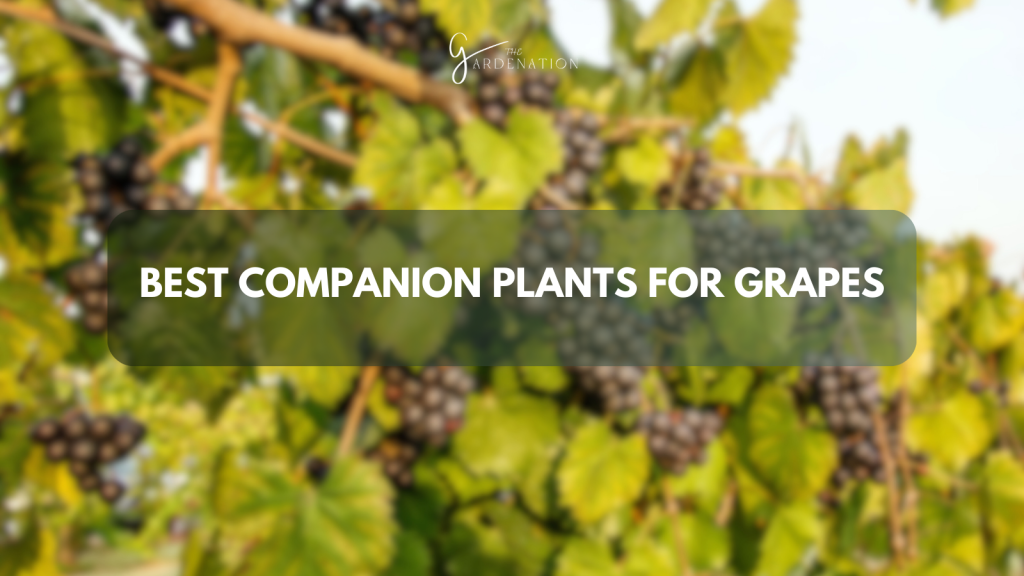Companion Plants For Grapes
Grapevines (vitis vinifera) are of various importance-from using them for vertical gardening to shades covers, from growing them for food to their ecological benefits in preventing erosion. And then growing companion plants for grapes in a place enhances its importance both economically and ecologically.
Selecting plants for house gardening – grapevines can be a good choice not only because they give sweet-juicy fruits but also because they are good climbers. So they have great importance in vertical house gardening using them for wall covers and in food processing for making jam, jelly and even grape wine.
What is Companion Planting?
Before moving forward let me explain what companion planting is. It is a method of growing different varieties of plants side to your main crop or plant for their mutual benefits. It involves strategic approaches in planting different varieties that support each other, in their growth, pest management and as well as improving soil fertility status.
For more information about Gardening you can visit: Zucchini Plant Growth Stages
Different methods of companion planting are used i.e, traditional pairings, succession pairing, vertical gardening, trap cropping and cover cropping. Considering soil status, weed and pest concentration, climate and erosion control, the most suitable method can be selected.
I prefer cover cropping as the most suitable method for companion planting of grapevines. Cover Cropping has numerous advantages such as:
- Cover crops like clover improves soil structure as well as increase organic matter and enhance soil fertility.
- Using tall crops provide support to vines for climbing up the wall.
- Using beans (nitrogen-fixing legume) increases soil fertility status.
- Short plants used for ground covers increase aesthetics of the garden as well as prevent soil erosion.
In short, in companion planting each variety of plant plays its own specific role for environment and main crop. But selecting appropriate cover plants is important in order to prevent competition between our main crop and the other.
Benefits of Companion Planting:

Selecting companion plants for grapevines – one must first be aware of the benefits of this strategy. Successful gardening can be practiced by using this method as it prevents use of chemicals in the garden, prevents diseases and encourages healthy growth of plants.
Following are the ways that companion plants are helpful:
Space Utilization
First and foremost benefit of companion planting is it utilizes left out spaces in the garden. Planting different sizes of crops in gaps between main crops can be effective as shorter plants that require less sunlight can be grown in these spaces proving it beneficial economically and aesthetically making efficient use of sunlight.
Nutrient management
One of the great health benefits of companion plants for grapes involves its nutrient management improving soil health and fertility status. Some plants have deep roots that can break up compacted soil, while others can fix nitrogen from the air in soil, enriching it for neighboring plants.
Pest Control:
Using chemicals for controlling pests in gardens is not favorable for the environment and is also costly. Companion planting is a great solution in this regard. Certain plants have the ability to attract pests due to their aroma and visual appearance. Using flowers and small covers along with grapevines can attract pests towards them, securing our main crop from pest attack.
Pollination Enhancement
Besides attracting pests certain plants attract pollinators towards them ultimately increasing the production of the main crop. Pollinators like insects are attracted towards them and in their journey they transport pollen, increasing the fruit set.
Trap Cropping:
This can be defined as sacrificing one life for another. Certain plants and groundcovers are added to attract pests towards them, preventing them from moving towards valuable crops.
For example, using planters that have a strong aroma such as onion and garlic can help hide main crops. Similarly herbs can also be used for the same purpose with the additional advantage of attracting pollinators. Ability of companion crops to attract pests towards them also play their role in biological control of pests, as higher species of pests prey on smaller ones.
Best Companion Plants for Grapes:

Growing grapes can be fruitful and are versatile plants that can be cultivated for various purposes, including fresh consumption, winemaking, juice production and producing raisins. When embarking grape cultivation, several key factors should be considered to ensure success.
First is selection of the right grape variety according to climate and soil. Warm summer with ample sunlight and well-drained soil is most suitable. So planting grapevines should be done in early spring or late fall, when the vines are dormant. Spaces between vines depend on the specific variety but ideally they are spaced 6-10 ft apart.
Now, I have explained briefly how these vines are planted and there will be 6-10ft unused space left that will be our spot for planting companion plants.
Companion planting for grapes involves strategically selecting plants to grow alongside grapevines, enhancing vineyard biodiversity and ecosystem health. Different varieties of herbs, fruits, vegetables and ornamental plants like marigolds, roses, geraniums, sunflowers can be used.
These plants enhance soil fertility, nitrogen fixation, nutrient status of soil as explained above along with guarding our grape vine from pests attack, that nourish our growth and fruit quality and also play a great role in balancing the ecosystem.
Following the context now I will describe different companions of grapevines and their importance for our crop.
Fruits and Vegetables

Strawberries: Strawberries are low-growing fruits that serve as living mulch increasing organic matter content in soil. They also play their part in suppressing weeds and conserving soil moisture around grapevines.
Raspberries: Raspberries are beautiful ground covers just like strawberries. They benefit grapes by attracting beneficial insects and also provide additional fruit that has its own unique tastes and benefits. Their key role is increasing pollination for the main crop.
Blueberries: Blueberries have a shallow root system playing a key role in maintaining soil health as they are acidophile species. Their sharp color and value attract insects towards them and contribute importantly in increasing the overall biodiversity of the garden. That makes them a very suitable companion for grapevines.
Tomatoes: Tomatoes as a companion for grapevines protect them from insects. It has the ability to repel harmful pests like aphids and whiteflies making them a very suitable companion. Moreover no one can deny the importance of the production of this plant.
Cucumbers: Cucumbers have crawling growth habits and can be planted between rows of grapevines, making efficient use of space while ground covers. Additionally, they are important to be used in salads, pickles and beneficial for skin
Lettuce: Lettuce a leafy green vegetable has a shallow root system making it a suitable companion for grapevines. They regulate moisture content in soil and suppress weeds. It also provides a beautiful ground cover.
Herbs and Shrubs

Lavender: Lavender, an evergreen plant belonging to the mint family can be a good choice for companion cropping. It has an ability to attract beneficial insects like bees and predatory insects due to its sharp beautiful colors. So it plays its role in pollinating grapevines.
Rosemary: It is an aromatic evergreen shrub with charming colors. It reduces pests like mosquitoes and also increases the aesthetic value of the garden.
Thyme: Thyme a herb is a great value companion plant for grapevines. Relative to oregano and due to its antimicrobial properties it helps prevent soil-borne diseases proving itself beneficial for the health of grapevines. It is also important for medicinal purposes.
Basil: Basil is a great culinary herb. Using it for companion planting in grapevines repels harmful pests and enhances the flavor of grapes when planted nearby. It benefits growers as it is a cure to many stomach problems and stomach ache.
Sage: Sage is known for its aromatic leaves, which can repel pests like cabbage moths and carrot flies when planted near grapevines. Additionally, sage attracts pollinators increasing the growth of fruit.
Flowers

Marigold: Marigolds are vibrant, aromatic flowers that emit a strong scent that repels harmful pests like nematodes, aphids and whiteflies and even nematodes. They can prove to be a good companion as they have a shallow root system that prevents competition with grape vines. Additionally, it attracts beneficial insects that can prey on harmful insects.
Nasturtiums: Nasturtiums belonging to Trapaeolum spp. Are colorful edible flowers that attract pollinators and beneficial insects while repelling pests. They provide a beautiful landscape to the vineyard. So they are a good choice providing both culinary and aesthetic benefits to the vineyard.
Cosmos: They are pink, white and purple color daisy-like flowers. Due to these various cheerful colors they attract bees and butterflies supporting grapevine pollination and fruit development.
Their wide foliage and graceful appearance add elegance to the landscape of vineyard.
Calendula: Calendula are orange or yellow colored flowering plants that have great aesthetic value as well as food and medicinal uses. Attracting pollinators and increasing fruit production is their key role for grapevines. Otherly they can be used to add color and flavor to salads and soups.
Sweet Alyssum: They are white, pink and purple color flowers. It is a low growing flowering plant with clusters of tiny aromatic blooms. It is also beneficial for attracting beneficial insects like lacewings and parasitic wasps, which prey on aphids and other pests. Besides providing a beautiful landscape in the vineyard it gives a fragrant ecosystem.
Best Groundcover Companions Plants for Grapes

Corsican Mint: It is small lavender-colored flowers that are low growing herbaceous perennial with tiny fragrant leaves. It forms dense foliage and suppresses weeds providing an aromatic ecosystem in the vineyard. It also protects plants from rodents and ants.
Blue Star Creeper: It is a creeping perennial plant. It can be identified by its star shaped blue flowers and bright green foliage that spread rapidly to form dense ground cover. As a companion it suppresses weed for grapevines and provides a charming landscape.
Lamb’s Ear: This plant has great ability to tolerate drought stress. About its appearance it has soft, velvety leaves and spikes of pink and purple flowers.. It has significant importance as companion plants such as weed suppression, attracting pollinators and provision of a beautiful vineyard landscape.
Frequently Asked Questions About Companion Plants For Grapes
What are bad companions for grapevines?
Yes, there are a lot of plants that can prove to be a bad companion for grapevines. They can have a harmful effect on plant growth as well as on soil and nutrient status of fields. For instance I don’t recommend growing onions around grapevines. Due to their nutrient requirement they are direct competition for our crop reducing overall productivity.
Can we use larger plants for companion cropping?
Larger plants like trees are also good companion plants. Such as apples and guavas can be used. They provide trellises for the grapevine to climb and shelter it from strong wind. Similarly, other taller crops can be used for this purpose, corn is important in this regard.
Conclusion
I have explained what companion planting is and its importance. Companion planting is important for a plant to maintain its nutritional status as well as soil health. It also plays a great role in protecting plants from harmful pests and diseases. Moreover they are beneficial in providing beautiful landscapes and have their own productivity that is economical for growers.

